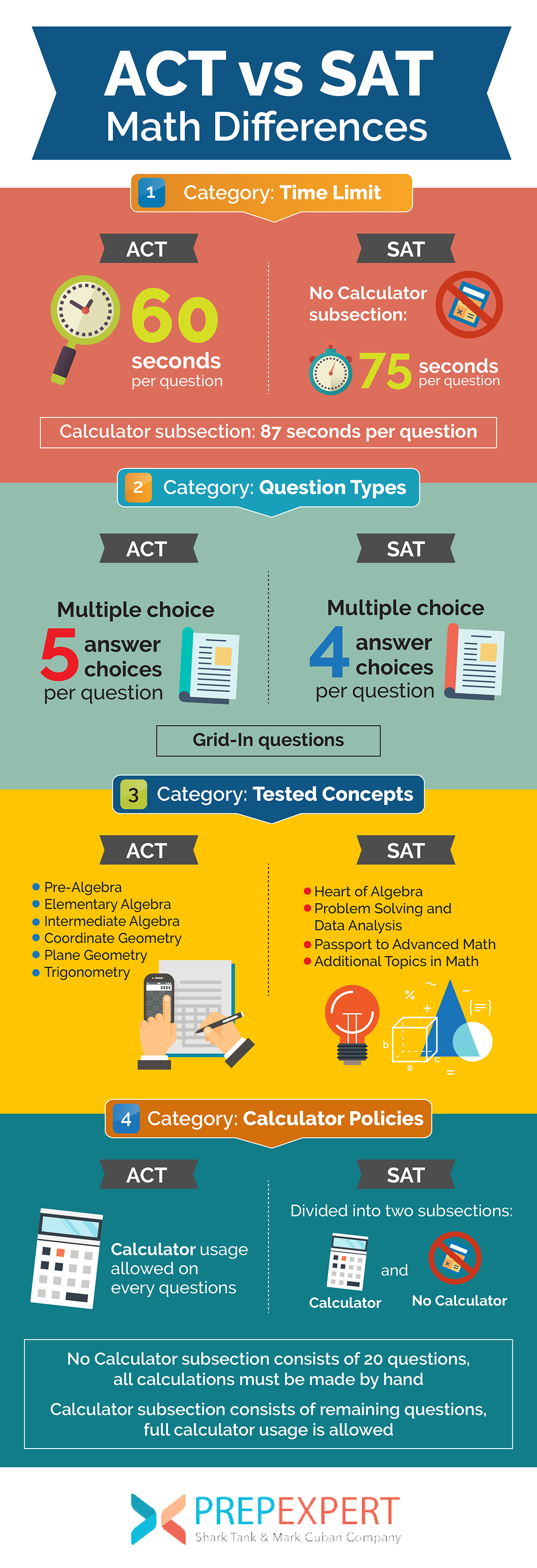ACT vs SAT Math Differences
Many people out there don’t like dealing with Math more than is absolutely necessary, especially when it comes to tests. Unfortunately, the SAT and ACT will test you thoroughly on a number of Math concepts you need, in order to prove your knowledge and succeed in college.
Here are some of the key ACT vs SAT Math differences to be aware of when deciding which test you should study for and take ultimately.
If you need help with brushing up on your Math skills, then don’t hesitate to check out our SAT prep and ACT prep courses available year-round.
[sat_one]


ACT vs SAT Math Time Limit
One of the first differences to be aware of applies not only to Math but both tests overall are the time limit.
If you are a person who is not 100 percent confident in their ability to solve Math problems quickly and accurately…then the ACT is going to present you with trouble. The ACT Math section is rigorously timed, allowing 60 seconds per question maximum.
The SAT Math section, because of its restructuring, is divided into two subsections: Calculator and No Calculator. The Calculator section allows test-takers 87 seconds per question, while the No Calculator section allows 75 seconds for each question.
We will go into the differences between these sections later, but it’s easy to see that the SAT allows you a good 15-30 seconds more of time to tackle a question you’re confused about. All added up, the SAT Math section is ten minutes longer than the ACT equivalent; make every extra second count if you need it.
[leadmagnet_five]

ACT vs SAT Math Question Types
After time limits, the next major difference to keep an eye on is the number of available question choices and overall structure.
Once again, look to the ACT to be more stringent; all of the questions are multiple-choice, that’s the good news. The bad news is there are five possible answers for each question. On the SAT, you are presented with four answer options on their multiple-choice questions.
Remember now that both tests utilize rights-only scoring, which means that you will not lose a point for an incorrect answer. In practical terms, if you honestly can not figure out a Math question and need to guess, your chances are better on the SAT than the ACT for getting it right. The SAT provides a five percent higher probability of guessing correctly than not.
While you should not strive to guess on questions, knowing which one gives you a greater probability of succeeding makes a difference. However, while the ACT does multiple-choice only for Math, the SAT throws in other questions for you to solve too. We’ll discuss those questions next.

SAT Grid-In Questions
Despite the slightly higher chance of screwing up guesses, the ACT does at least stick with multiple-choice questions only.
On the SAT, there are 13 “grid-in” questions; these questions require the student to actually fill in the answer using a designated grid on their answer sheet. No choices are provided, so the prospect of trying to guess your way out is eliminated entirely. Moreover, these 13 questions are spread across the aforementioned Calculator and No Calculator sections.
The worst-case scenario for a bad Math student is coming across a No Calculator Grid-In question requiring doing the calculations quickly by hand and hoping to have the right answer because answer choices are not provided. Think about that potential scenario when deciding which test to study.

ACT vs SAT Math Concepts
Let’s pivot now from the kinds of questions asked, to what questions both tests will ask you.
When comparing the old SAT Math section with the new one, the new one stepped it up difficulty-wise. Students now are tested more advanced Math concepts than previously included, such as basic trigonometry and complex numbers. The College Board breaks down the Math section content into three categories: Heart of Algebra, Passport to Advanced Math, and Problem Solving and Data Analysis.
Ninety percent of the questions you’ll face will be in one of these categories. The remaining ten percent will be comprised of Additional Topics, which include basic trigonometry, geometry, and complex numbers.
Here’s what the SAT questions are looking for from students (according to the College Board official website):
- Create, solve, or interpret a linear expression or equation in one variable that represents a context.
- Create, solve, or interpret linear inequalities in one variable that represent a context
- Build a linear function that models a linear relationship between two quantities
- Create, solve, and interpret systems of linear inequalities in two variables
- Create, solve, and interpret systems of two linear equations in two variables
- Algebraically solve linear equations (or inequalities) in one variable
- Algebraically solve systems of two linear equations in two variables
- Interpret the variables and constants in expressions for linear functions within the context presented
- Understand connections between algebraic and graphical representations
- Use ratios, rates, proportional relationships, and scale drawings to solve single- and multi-step problems
- Solve single- and multi-step problems involving percentages
- Solve single- and multi-step problems involving measurement quantities, units, and unit conversion
- Given a scatter plot, use linear, quadratic, or exponential models to describe how the variables are related
- Use the relationship between two variables to investigate the key features of the graph.
- Compare linear growth with exponential growth
- Use two-way tables to summarize categorical data and relative frequencies, and calculate the conditional probability
- Make inferences about population parameters based on sample data
- Use statistics to investigate measures of the center of data and analyze shape, center, and spread
- Evaluate reports to make inferences, justify conclusions, and determine the appropriateness of data collection methods
- Create a quadratic or exponential function or equation that models a context
- Determine the most suitable form of an expression or equation to reveal a particular trait, given a context
- Create equivalent expressions involving rational exponents and radicals, including simplifying or rewriting in other forms
- Create an equivalent form of an algebraic expression by using structure and fluency with operations
- Solve a quadratic equation having rational coefficients
- Add, subtract, and multiply polynomial expressions and simplify the result
- Solve an equation in one variable that contains radicals or contains the variable in the denominator of a fraction
- Solve a system of one linear equation and one quadratic equation
- Rewrite simple rational expressions
- Interpret parts of nonlinear expressions in terms of their context
- Understand the relationship between zeros and factors of polynomials, and use that knowledge to sketch graphs
- Understand a nonlinear relationship between two variables by making connections between their algebraic and graphical representations
- Use function notation, and interpret statements using function notation
- Use structure to isolate or identify a quantity of interest in an expression or isolate a quantity of interest in an equation
The ACT, on the other hand, has always been known for testing slightly more advanced mathematical concepts. In order to thrive, it’s important to be comfortable with arithmetic, algebra, and geometry. While the new SAT format attempts to compete, the ACT still dives deep into a number of subjects that students have to prepare for thoroughly.
For example, the ACT will test you on concepts such as imaginary numbers, logarithms, and advanced geometry in greater detail than the SAT. The Math section is subdivided into three main Content areas: Preparing for Higher Math, Integrating Essential Skills, and Modeling.
Here is a breakdown of what to prepare for in the ACT Math section, according to the official ACT website:
- Demonstrate knowledge of real and complex number systems.
- Demonstrate understanding and reason with numerical quantities in many forms, including integer and rational exponents, and vectors and matrices.
- Solve, graph, and model multiple types of expressions, many of which employ different kinds of equations, such as linear, polynomial, radical, and exponential relationships.
- Demonstrate knowledge of function definition, notation, representation, and application. Questions may include linear, radical, piecewise, polynomial, and logarithmic functions.
- Define and apply knowledge of shapes and solids, such as congruence and similarity relationships or surface area and volume measurements.
- Understand the composition of objects, and solve for missing values in triangles, circles, and other figures, including using trigonometric ratios and equations of conic sections.
- Describe the center and spread of distributions
- Apply and analyze data collection methods
- Understand and model relationships in bivariate data
- Calculate probabilities, including the related sample spaces
- Demonstrate the ability to produce, interpret, understand, evaluate, and improve models
It may appear that the new SAT is more grueling, but make no mistake, the ACT will tax a student’s math skills more in-depth in general. However, there’s also the question of how a calculator can help you out on test day. That’s what we’ll cover next.
[sat_two]

ACT vs SAT Math Calculator Policies
If all this information is stressing you, don’t worry, you can still use your calculator on both tests…for the most part.
Here’s the good news – on the ACT, you can use a calculator on every single question. Even though the questions you face will be more in-depth, you won’t be forced to work out the calculations for them by hand. And since you only have 60 seconds per question, it’s important to get as much calculator practice as possible on practice tests.
Here’s the bad news – on the SAT, you are going to have to go without it for a number of questions. Why? Because the new SAT Math section has been divided into Calculator and No Calculator subsections. The No Calculator currently consists of 20 questions, taking up around 25 minutes of your time. The good thing about these questions is that they are designed to be easier to solve without a calculator than with one. As a result, they tend to be more involved with pure reasoning than arithmetic.
Remember though, on both the SAT and ACT, the questions are designed so that technically you should be able to solve them without a calculator at all. Practically speaking though, if you aren’t confident in your math skills to solve problems quickly without one, then the ACT is a better bet for you.
[leadmagnet_two]

Let Prep Expert Prepare You For ACT or SAT Math
Still not sure which test to take, based on the Math differences? Don’t worry, we have you covered with both tests.
Focused test prep, like what Prep Expert offers, will help you identify the information you need to have, figure out your strengths and weaknesses in those sections, and practice both fixing weaknesses and sharpening strengths.
If you haven’t done so already, take a moment to check out what we have to offer regarding both ACT and SAT prep, including how to handle those dreaded Math sections.
[sat_three]
For more test strategy, college admissions, and scholarship application tips sign up for our FREE class happening right now!
ACT vs SAT Math Differences FAQ
How much time do I get to finish the SAT vs ACT Math sections?
The ACT Math section is rigorously timed, allowing 60 seconds per question maximum. The SAT Math section, because of its restructuring, is divided into two subsections: Calculator and No Calculator. The Calculator section allows test-takers 87 seconds per question, while the No Calculator section allows 75 seconds for each question.
What are the questions like on each test?
Once again, look to the ACT to be more stringent; all of the questions are multiple-choice, that’s the good news. The bad news is there are five possible answers for each question. On the SAT, you are presented with four answer options on their multiple-choice questions.
Can I use a calculator?
On the ACT, you can use a calculator on every question. On the SAT, there is a specific No Calculator section where you must work out problems by hand.
Which one requires you to know more Math concepts?
The ACT will test you on concepts such as imaginary numbers, logarithms, and advanced geometry in greater detail than the SAT.